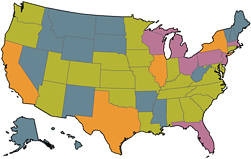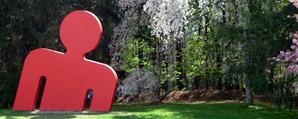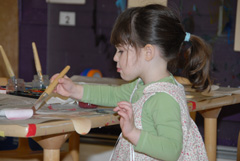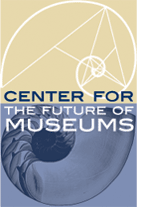When it comes to viewing great art, Americans face a disparity of opportunity — a fact that has always troubled me. It may be politically incorrect, but it shouldn’t be controversial to say that most of the best visual art in the United States lies east of the Mississippi, largely because the East’s museums had a head start. They were richer, and more conscious of catching up with sophisticated Europe, first.
 What is more troubling is the perpetuation of this pattern, partly because of money and partly because some areas are better than others at developing and/or maintaining a tradition of funding the arts.
What is more troubling is the perpetuation of this pattern, partly because of money and partly because some areas are better than others at developing and/or maintaining a tradition of funding the arts.
Or so the story has always gone. Now the Foundation Center has provided some analysis — emphasis on “some” — to back up the thesis, and it has displayed its results in a fascinating “Focus on Arts Funding” interactive map that illustrates regional differences.
The map has limitations: it maps not grants, but the location of grantmakers funding arts and culture, an assumption presumably being that at least some focus more on local/regional giving than national giving (in my experience, a reasonable assumption).
What you will see if you go to the Foundation Center site (link below) and click on a category (on the left, “arts, general,” “humanities,” “museums,” “performing arts,” etc.) is the distribution of grantmakers in that category. Mouse over any given chosen state, and you get the actual number of grantmakers in that state.
So, it’s no surprise that New York consistently comes out on top, in every category. Is it shocking to see that South Dakota, Arkansas and Mississippi have no grantmakers in the visual arts?
Or that, only New York, Pennsylvania and Massachusetts have a sizable number of grantmakers interested in historical activities?
By all means take a look.
So as not to overstate the case, let me repeat what I have said before: Foundations provide a small share of arts funding.
Nevertheless, there’s a problem here. My solution is more, and less equal, partnerships — with richer arts institutions sharing more with those out of their league, which is to say below it.

 Nothing could be further from the truth. I’m for arts education, no matter how we get it done — and where. In fact, among the items of interest that I’ve saved in the last few weeks to comment on here is one about a museum pre-school.
Nothing could be further from the truth. I’m for arts education, no matter how we get it done — and where. In fact, among the items of interest that I’ve saved in the last few weeks to comment on here is one about a museum pre-school. The deCordova is building on an existing relationship with the Lincoln Nursery School, which “has taken advantage of deCordova’s campus by exploring, discovering, and learning about the sculpture, art, and landscape. For example, in the fall of 2009, Lincoln Nursery School students visited the Sculpture Park for a field trip and soon after, created their own sculpture at the Lincoln Nursery School, inspired by Steven Siegel’s environmentally-friendly newspaper installation, Big, with rift.”
The deCordova is building on an existing relationship with the Lincoln Nursery School, which “has taken advantage of deCordova’s campus by exploring, discovering, and learning about the sculpture, art, and landscape. For example, in the fall of 2009, Lincoln Nursery School students visited the Sculpture Park for a field trip and soon after, created their own sculpture at the Lincoln Nursery School, inspired by Steven Siegel’s environmentally-friendly newspaper installation, Big, with rift.” Why are we all for arts education?
Why are we all for arts education?  Real Clear Arts readers know that I am a fan of The Wall Street Journal’s Saturday
Real Clear Arts readers know that I am a fan of The Wall Street Journal’s Saturday  So I put the idea aside. Now someone at Best Colleges Online has come up with a list of “50 Awesome Art Museum Blogs.” I had to look.
So I put the idea aside. Now someone at Best Colleges Online has come up with a list of “50 Awesome Art Museum Blogs.” I had to look.